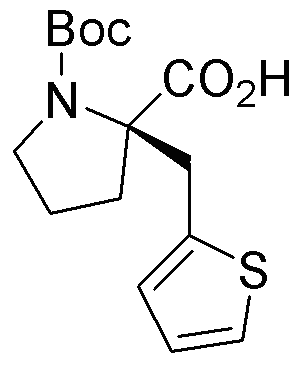|
Boc-(R)-a-(2-thiophenylmethyl)proline is widely utilized in research focused on:
- Peptide Synthesis: This compound serves as a valuable building block in the synthesis of peptides, particularly in the creation of cyclic peptides that are crucial for drug development.
- Pharmaceutical Development: Its unique structure enhances the bioactivity of pharmaceutical compounds, making it a key player in the design of new medications targeting various diseases.
- Biotechnology: In the field of biotechnology, it is used to modify proteins, improving their stability and functionality, which is essential for therapeutic applications.
- Research in Neuroscience: The compound's properties make it useful in studying neuroactive peptides, contributing to the understanding of neurological disorders and potential treatments.
- Drug Delivery Systems: It can be incorporated into drug delivery systems, enhancing the solubility and bioavailability of poorly soluble drugs, thus improving therapeutic outcomes.
General Information
Properties
Safety and Regulations
Applications
Boc-(R)-a-(2-thiophenylmethyl)proline is widely utilized in research focused on:
- Peptide Synthesis: This compound serves as a valuable building block in the synthesis of peptides, particularly in the creation of cyclic peptides that are crucial for drug development.
- Pharmaceutical Development: Its unique structure enhances the bioactivity of pharmaceutical compounds, making it a key player in the design of new medications targeting various diseases.
- Biotechnology: In the field of biotechnology, it is used to modify proteins, improving their stability and functionality, which is essential for therapeutic applications.
- Research in Neuroscience: The compound's properties make it useful in studying neuroactive peptides, contributing to the understanding of neurological disorders and potential treatments.
- Drug Delivery Systems: It can be incorporated into drug delivery systems, enhancing the solubility and bioavailability of poorly soluble drugs, thus improving therapeutic outcomes.
Documents
Safety Data Sheets (SDS)
The SDS provides comprehensive safety information on handling, storage, and disposal of the product.
Product Specification (PS)
The PS provides a comprehensive breakdown of the product’s properties, including chemical composition, physical state, purity, and storage requirements. It also details acceptable quality ranges and the product's intended applications.
Certificates of Analysis (COA)
Search for Certificates of Analysis (COA) by entering the products Lot Number. Lot and Batch Numbers can be found on a product’s label following the words ‘Lot’ or ‘Batch’.
Numéro de catalogue
Numéro de lot/série
Certificates Of Origin (COO)
This COO confirms the country where the product was manufactured, and also details the materials and components used in it and whether it is derived from natural, synthetic, or other specific sources. This certificate may be required for customs, trade, and regulatory compliance.
Numéro de catalogue
Numéro de lot/série
Safety Data Sheets (SDS)
The SDS provides comprehensive safety information on handling, storage, and disposal of the product.
DownloadProduct Specification (PS)
The PS provides a comprehensive breakdown of the product’s properties, including chemical composition, physical state, purity, and storage requirements. It also details acceptable quality ranges and the product's intended applications.
DownloadCertificates of Analysis (COA)
Search for Certificates of Analysis (COA) by entering the products Lot Number. Lot and Batch Numbers can be found on a product’s label following the words ‘Lot’ or ‘Batch’.
Numéro de catalogue
Numéro de lot/série
Certificates Of Origin (COO)
This COO confirms the country where the product was manufactured, and also details the materials and components used in it and whether it is derived from natural, synthetic, or other specific sources. This certificate may be required for customs, trade, and regulatory compliance.


